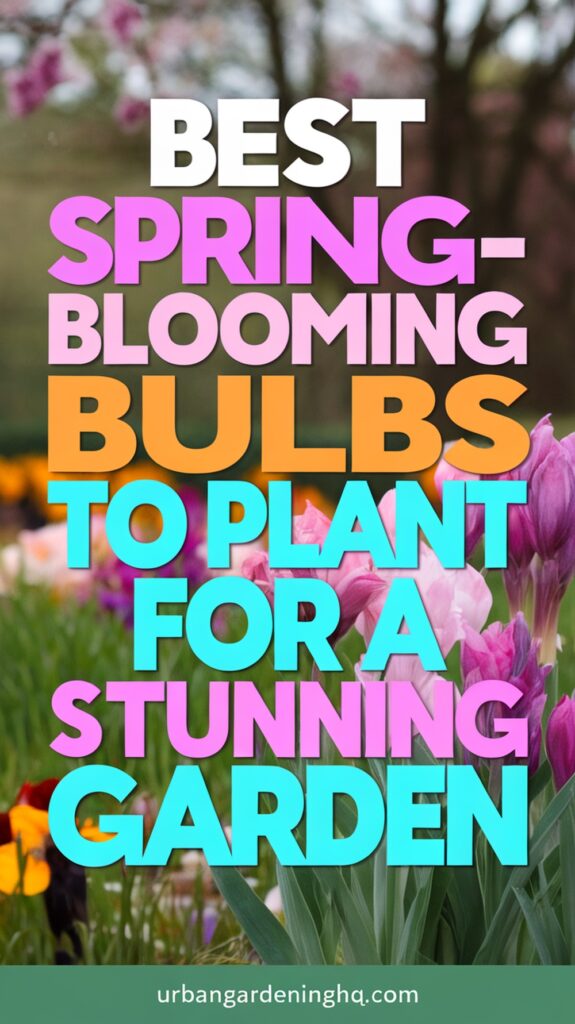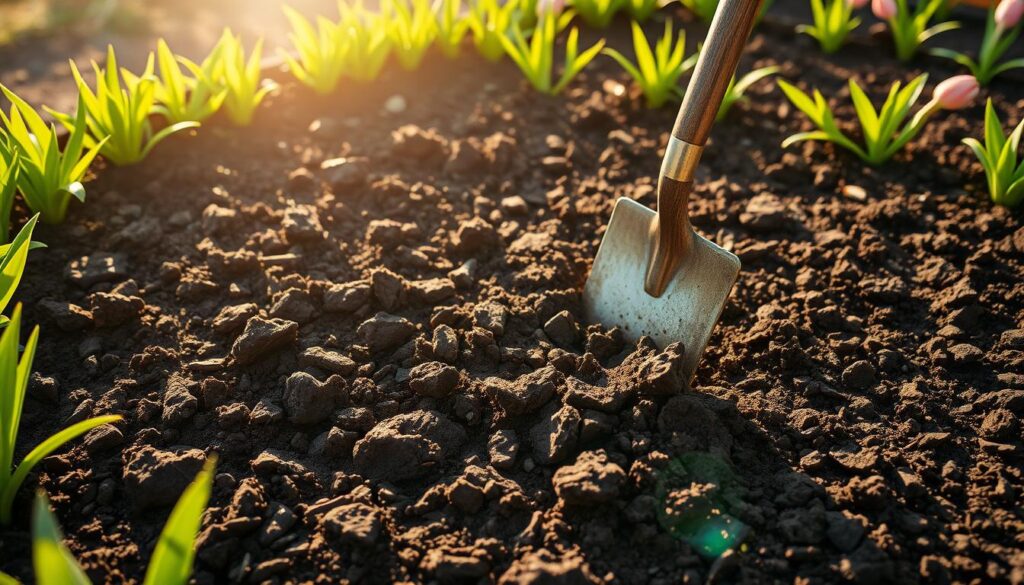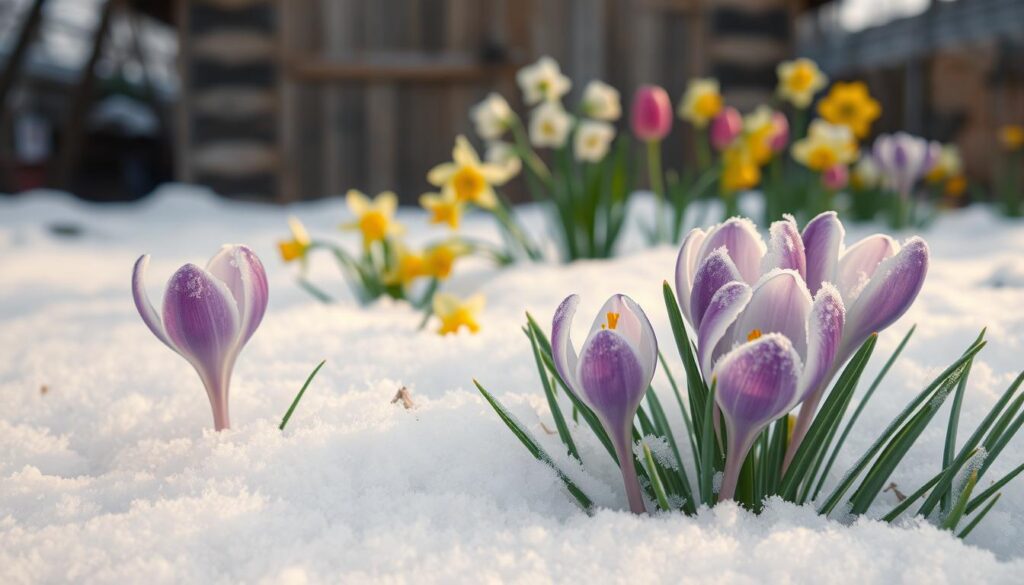I’m excited to share the best Spring-Blooming Bulbs for a stunning garden. With over 100 species of Tulips and 100 species of Fritillaria, your garden will burst with color. Daffodils, Crocuses, and Hyacinths are also great choices to make your garden beautiful.
When planning my garden, I look at different Spring-Blooming Bulbs like Tulips, Daffodils, and Crocuses. These bulbs are perfect for a vibrant spring display. With the right care, they’ll add stunning color and beauty to your garden.
Planting bulbs like Tulips, Daffodils, and Crocuses will make your garden stand out. This article will guide you on the best bulbs to plant. You’ll also learn how to plant and care for them.
Understanding Spring-Blooming Bulbs and Their Magic

Spring-Blooming Bulbs are special in the garden world. They have a unique Life Cycle that makes them stand out. These bulbs sleep through the summer and wake up in the spring to bloom.
The best time to plant them is after Halloween and before Thanksgiving. This lets them grow strong before winter. Knowing their Life Cycle helps gardeners enjoy their beauty and growth.
- They need well-drained soil to avoid rot.
- Plant them 2-3 times deeper than their widest part.
- Space them close but not touching to stop rot.
By following these tips, gardeners can create a beautiful display of color and Magic in their gardens.
When to Plant Your Spring-Blooming Bulbs
When planning my garden, I always think about the best time to plant Spring-Blooming Bulbs. Planting them in the fall, 6-8 weeks before the first frost, is key. This lets them grow in the soil all winter and bloom in the spring.
For planting tips, it’s important to know the bulb type and your area’s climate. For instance, daffodils, tulips, and snowdrops go in late summer to early fall. Hyacinths and crocus are best in early to mid-fall. Alliums should be planted in fall, 6-8 weeks before the ground freezes.
Here are some planting guidelines for different climates:
- In zones 1-4, plant in early September
- In zones 5-6, plant in late September to early October
- In zones 7-8, plant in early November
- In warmer areas (zones 9-11), bulbs need 8 to 10 weeks of chilling in the fridge before planting
By following these tips and choosing the right planting time, you’ll have a beautiful garden in the spring.
Top Spring-Blooming Bulbs for American Gardens
Exploring spring-blooming bulbs is exciting. I’m eager to share the best ones for American gardens. Choosing the right bulbs can be tough, but tulips, daffodils, crocuses, and hyacinths are top picks.
These bulbs do well in many climates and soils. Tulips fit zones 3-8, while daffodils thrive in clay soils and zones 3-9. Crocuses and hyacinths are great for zones 3-8 and 3-9, respectively, and are native to North America.
Here are some key characteristics of these top spring-blooming bulbs:
- Tulips: come in a variety of colors and are suitable for USDA Hardiness Zones 3-8
- Daffodils: resilient in clay soils and suitable for Zones 3-9
- Crocuses: can be planted in Zones 3-8 and are one of the first signs of spring
- Hyacinths: grow well in Zones 3-9 and are native to North America
Planting these bulbs will make your garden vibrant and colorful in spring. With the right care, they’ll grow and bloom year after year.
| Bulb Type | USDA Hardiness Zone | Soil Type |
|---|---|---|
| Tulips | 3-8 | Well-draining |
| Daffodils | 3-9 | Clay |
| Crocuses | 3-8 | Well-draining |
| Hyacinths | 3-9 | Moist |
Creating Color Combinations with Spring Bulbs
To make a stunning garden, it’s key to know how to mix colors with spring bulbs. You can pair tulips with daffodils for a beautiful look. Also, layer different bulbs like crocus and scilla in groups of 20 to 30. Plant larger bulbs like daffodils and tulips in groups of 10 or more.
When planning your garden, think about bulb garden design principles. Match flower bulbs to your home’s colors. Design with spring bulbs for a unique garden. Here are some tips:
- Plant taller bulbs towards the back and shorter bulbs towards the front
- Use a mix of colors and textures to add depth and interest
- Consider using neutral tones like low-maintenance perennials to complement your spring bulbs
Follow these tips and learn to mix colors with spring bulbs. You’ll create a stunning garden that blooms with beauty and color.
Essential Tools for Planting Spring Bulbs
Planting spring bulbs needs the right tools for success. As I get my garden ready for spring, I make sure I have everything I need. Experts say garden forks, trowels, and bulb planters are key. These tools make planting tulips and daffodils easy and precise.
I start by using a garden fork to loosen the soil. Then, I dig holes with a trowel for my bulbs. A bulb planter is great for planting lots of bulbs. For more tips, I check out the ultimate guide to planting spring bulbs.
Here are some essential tools for planting spring bulbs:
- Garden fork
- Trowel
- Bulb planter
These tools help me create a stunning garden full of spring bulbs.
Soil Preparation and Planting Depth Guidelines
When I’m ready to plant my Spring Bulbs, I know how key Soil Preparation and Planting Depth are. A successful garden starts with these basics. First, I make sure my soil drains well and is full of nutrients. Adding compost or bulb fertilizer helps a lot.
Bulbs need at least five hours of sunlight a day to grow well. This is what I’ve learned.
For Planting Depth, the rule is to plant bulbs three times their height deep. But, some bulbs like Snowdrops need only 10 cm, while Tulips need 20 cm. Planting too deep can mean no flowers or just leaves.

To help my bulbs grow, I plant them in groups. Small bulbs go one to two inches deep and apart. Large ones go four to six inches deep and apart. Regular watering, based on the weather, is also important. This way, I’ll have a beautiful garden with vibrant Spring Bulbs in the spring.
Some important tips to remember are:
- Planting bulbs in the fall for spring bloom
- Using compost or bulb fertilizer to enhance growth
- Planting bulbs at the correct depth for their type
- Watering bulbs regularly, depending on weather conditions
Protecting Your Bulbs from Pests and Wildlife
To make sure your Spring Bulbs thrive, it’s key to keep them safe from pests and wildlife. Urban gardening experts say protecting them is vital for their growth and beauty. You can use physical barriers, repellents, or choose pest-resistant bulbs to keep them safe.
Some bulbs, like daffodils and snowdrops, have a bitter taste that keeps animals away. But, other bulbs, like tulips and crocus, attract wildlife more. To protect them, use hardware cloth barriers with ½-inch openings. This keeps small pests out while letting plants grow.
- Plant bulbs at least three times their height deep to make them harder for pests to dig up
- Use chicken wire or hardware cloth over the planting area and hold it in place with stakes or weights
- Add sharp gravel or crushed oyster shells around the bulbs to scare off squirrels
By using these Pest Control and Wildlife Protection tips, you can make sure your Spring Bulbs bloom beautifully.
Winter Care for Spring-Blooming Bulbs
As winter comes, it’s key to care for your Spring-Blooming Bulbs. They need the right care to bloom well in spring. This care includes Mulching and protecting them from harsh weather.
Most Spring-Blooming Bulbs need 12 to 16 weeks of cold to bloom. Keeping the soil moist and at the right temperature is important. Mulching helps with this. Here are some Winter Care tips:
Mulching Techniques
- Apply a 2-3 inch layer of mulch around your Spring-Blooming Bulbs to retain moisture and regulate soil temperature.
- Choose a well-draining mulch to prevent waterlogged soil, which can lead to rot and other problems.
- Replenish the mulch as needed to ensure it remains at the recommended depth.
Winter Protection Methods
There are more ways to protect your Spring-Blooming Bulbs from winter. You can cover the soil with straw or burlap. Also, avoid too much water to prevent rot.

By following these Winter Care tips, you’ll enjoy a beautiful spring display. Choose the right Mulching and protection for your bulbs. This way, they’ll get the best care.
Post-Bloom Care and Maintenance
After your Spring-Blooming Bulbs finish blooming, it’s key to care for them properly. This ensures they grow strong and healthy next year. Let the foliage die back naturally, which can take weeks to months, depending on the bulb and weather.
For more on caring for your Spring-Blooming Bulbs after they bloom, check out Longfield Gardens. They offer expert advice on Post-Bloom Care and Maintenance.
Some important tips for Post-Bloom Care and Maintenance include:
- Let the foliage die back naturally
- Don’t water too much during this time
- Use a low-nitrogen fertilizer to help bulb growth
By following these tips, you can ensure your Spring-Blooming Bulbs return strong and healthy each year. They add beauty and are easy to maintain in your garden.
Naturalizing Techniques for Long-Term Success
To get long-term success with spring-blooming bulbs, naturalizing is key. It lets bulbs multiply and spread, making your garden beautiful and sustainable. By picking the right bulbs and following simple tips, you can make a stunning bulb garden that lasts.
Great bulbs for naturalizing include daffodils, scilla, and chionodoxa. These bulbs resist pests and can last three to four years. Plant them at the right depth: small bulbs five inches deep, large bulbs eight inches deep. Use a slow-release fertilizer for healthy growth.

Creating natural-looking drifts is essential for a beautiful bulb garden. Plant bulbs in groups, like scilla siberica or chionodoxa in groups of 25. Tulips need groups of 12, and daffodils and alliums in groups of 3 or more. These tips help you create a stunning garden that lasts.
More tips include planting bulbs in different spots, like flower beds and sunny lawns. Planting bulbs with perennials hides fading foliage and looks better. With the right techniques and patience, your bulb garden will thrive for years.
Combining Spring Bulbs with Other Plants
When planning my garden, I think about mixing spring bulbs with other plants. This mix adds beauty and interest. The right plants can make my garden design pop.
Gardening experts say mixing bulbs with other plants is a smart move. It makes the garden look better and more complete. Plants like Azaleas, Rhododendrons, and Spring Phlox work well with bulbs.
Companion Planting Ideas
Here are some good plants to pair with spring bulbs:
- Azaleas and Rhododendrons like part shade and good drainage.
- Spring Phlox fills in gaps and grows low and wide.
- Lungwort and Heartleaf Brunnera have pretty leaves and hide bulb leaves.
Succession Planting Strategies
To make my garden look amazing, I use succession planting. This means planting bulbs that bloom at different times. Early, mid, and late spring bulbs create a colorful show all season.
Troubleshooting Common Bulb Problems
Exploring Spring-Blooming Bulbs, I see the need to fix common issues. Solving these problems is key to my bulbs’ success. This way, they can grow and bloom well.
Common problems include issues with blooming, growth, and pests. To fix these, I watch my bulbs closely. For example, if they don’t bloom, I check their sunlight and water.
Here are some common problems and their solutions:
- Non-blooming: Check for sufficient sunlight, water, and fertilizer.
- Pest damage: Use repellents like blood meal to deter rodents and other pests.
- Soft or rotting bulbs: Discard any bulbs that are soft or show signs of rot.
By following these tips, my Spring-Blooming Bulbs stay healthy. Remember, fixing common problems is vital for their care.
Conclusion
As we wrap up our exploration of spring-blooming bulbs, I’m sure you’re ready to make your garden pop. You now know how to pick and care for tulips, daffodils, crocuses, and hyacinths. This knowledge will help you turn your outdoor area into a lively and beautiful spot.
Success in gardening comes from careful planning and regular upkeep. Choose the right bulbs and plant them correctly for a beautiful show. Mix colors, layer bulbs, and protect your garden from pests and animals.
With the tips from this article, you’re set to become a spring bulb expert. Your garden will be a treat for the eyes and a source of joy for everyone who sees it. Start planting and let your garden show off your creativity. Happy planting!


